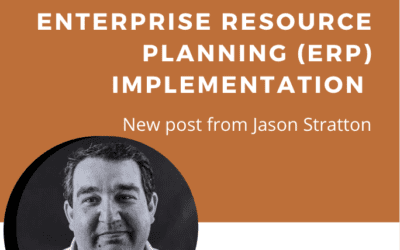For manufacturers business growth can be especially challenging. Aside from the big questions about HOW to actually grow the business, support considerations must be in place for success. For example, how do you build the infrastructure needed to support additional sales? How do you keep quality of production in place and maintain throughput despite increased demands? We have quite a few stories of companies doing this well, but the focus of this post is on increasing growth.
Paul Svendsen, an OMEP third party partner, points out that there are really only four ways to grow your business.
4 Ways to Grow Your Business
- Increase the number and type of customers
- Increase the number of times customers do business with you
- Increase the average value of each sale
- Increase the effectiveness of each process in your business
He goes on to say, “These four factors will give you critical focal points for your business. When combined together, they also give you leverage. For instance, given that you could increase each one of the factors above by just 10 percent (not too difficult a task), the total combined effect of that is an impressive 46 percent increase in your business.”
More is Not Always Best
You might create a better script for phone sales, or you could produce more informational content and reference materials to add value on your website, in an attempt to drive traffic and generate leads. Most business owners believe that more is always best. More advertisements, more web content, more social media posts, etc. These items might increase your visibility, but you will miss large opportunities unless you maximize the effectiveness of the processes behind them.
 Create Leverage
Create Leverage
A great example of leverage comes from Paul: “For many manufacturers, the majority of sales are a result of phone calls. Imagine that (like most) phone calls account for 60 percent of sales. Then, given that you could not change the effectiveness of your advertising, all you need to do to double your sales is to double your conversion rate. “
Use Feedback and Insights to Increase Your Conversion Rate
It is not easy to figure out which levers to pull to double that conversion rate. What’s affecting someone’s decision to convert? You can only double your conversion rate if you understand what to change.
Are you asking the right questions about your audience? Do your potential customers understand the benefits of your products? Are you sending the right message at the right time to the right person?
For example, if you are responding to a RFQ and the person on the receiving end was told by their boss to ‘buy the cheapest option’, your company’s superior customer service won’t convince him or her to pay more. However, if your RFQ response is addressed to someone who understands the true cost of wasted time and poor communications with their supplier, they will be impressed by your great customer service track record, and more willing to pay a bit more to get the value they are already seeking.
Understand Your WHO
The example above leads nicely into an important step in increasing your customer base – Target Marketing. Rather than sending the same message to everyone in your network, consider how subtle changes to wording, tone, value proposition and benefits can affect your sales.
Empathy is the key to marketing success. Understanding precisely who you are sending / selling/ talking to matters.
Invest time and energy into identifying not only the basic information about your ideal client, (company size, revenue, location, capabilities) but also his or her needs, decision-making framework tree, and desires. Focus on solving your customer’s problems, not a menu or list of benefits that are devoid of meaning. Segmenting your audience based on psychographics is difficult, but it can be a powerful path to success. Getting into what your customers actually WANT is key. You won’t know that until you know who they are.
Give Your Prospects the REAL Value of Your Product
It is vital that all advertising and marketing materials tell your clients about the value of the products from their perspective. Don’t give a list of features (very tempting for technical products!) but help them to see the benefit of the tool in their lives. Tap into those wants and needs we discussed earlier. People don’t want the drill they’re purchasing at the hardware store – they want the hole it can make for them. This value creation checklist from Seth Godin might be useful in asking the right questions.
Seth sums it up nicely: “The old model of mass marketing meant creating a product that appeals to an average buyer, then interrupting as many prospects as possible (with commercials, direct mail, sales calls, etc.), hoping to convince a percentage to buy. This is no longer effective because today’s consumers tune out any message that doesn’t interest them.
You have to “earn” the right to sell to people and this is only possible if you have a compelling story that shows how what you’re offering is different and better from everything else that’s available in the market.”
Focus on Customers Who have Already Purchased From You
One often overlooked area of target marketing is focusing on existing customers. Acquisition is expensive, so if you can keep existing clients coming back, you increase your value to them, and get greater ROI per client. According to a Harvard Business Review study, a 5% increase in customer retention can increase a company’s profitability by 85% Read more client retention strategies here: https://www.kinesisinc.com/mine-for-gold/
Create a Referral System
Harnessing the power of ‘word of mouth’ by creating a referral system could double your business for very little investment. If you’re doing a great job serving your customers, it can be very simple to put in a process to ask them to tell their network about you. Almost every business owner believes this is important, but few have taken the time to put a system in place to capture these referrals. Try training your sales team to ask for a referral when they check on their clients.
Experiment!
If you start to pull on these levers (existing clients, more effective sales and marketing processes, greater understanding of your whos, personalized benefits statements that tap into your audience’s desires), you will see your conversion rates begin to change. Track your progress, pay attention to what’s working and make changes as you go. Marketing and sales can benefit greatly from the Plan Do Check Act model.
Imperfect action is almost always better than perfect inaction.



